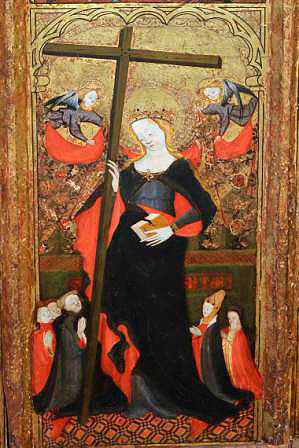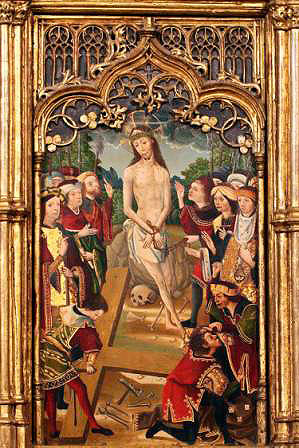26 May 2016
Gothic art in Navarre
15th century panel painting
Dr. Carmen Lacarra Ducay
University of Zaragoza
The Gothic panel painting carried out in the ancient kingdom of Navarre that is known through the works that have survived has its own characteristics, which have been marked by geography and history. Although it is true that it has little to do with the quality and magnificence of the mural painting produced during the same period, which is universally recognised, it was in the 15th century when panel painting was carried out, of which there remain some examples of interest and artistic value, B , of which a summary is given below.
From a chronological point of view, the first altarpieces belong to the first third of the 15th century and their style belongs to the so-called International Gothic, a style characterised by northern and Mediterranean influences, with meticulous drawing and brilliant polychromy carried out using the tempera technique. The oldest altarpiece is dedicated to Saints Nicasius of Reims and Sebastian, and is kept in the National Archaeological Museum in Madrid. A registration, on the leave part of the piece, states that it was commissioned by Don Martín Périz de Eulate and his wife, Doña Toda Sánchez de Yarza, neighbours of Estella, in 1402. Its interest lies in its unusual iconography and its early date, which marks the beginning of International Gothic in Navarre.
The second altarpiece is dedicated to the Holy Cross and was made at the request of the same Navarrese family in 1416, for the church of San Miguel Arcángel in Estella, where their funerary chapel, which is still preserved, was located. In both cases, the donors have been portrayed in a prominent place in the work, and the iconography of the narrative scenes depicted, based on the Golden Legend by Jacobo de la Vorágine, has been recreated with meticulous attention to detail.

Altarpiece of the Holy Cross, 1416
Church of San Miguel Arcángel, Estella
Finally, group closes the list of pictorial works belonging to the city of the Ega with the wooden chest that contained the sacred image of the Virgin of El Puy, preserved in the sanctuary, which has a door decorated on both fronts with Gothic paintings of an apostleship and an Annunciation, which may have been a gift from Queen Blanca of Navarre in gratitude for the healing of her son Carlos de Viana, who suffered from a serious illness in Estella in 1430. The lack of documentation on the authors of these three works, which have little in common except their provenance, makes it impossible to attribute them to a specific workshop. However, their mere presence in Estella and the documentary reference letter to other altarpieces in the same city, informs us of the presence of panel painters in the first decades of the 15th century.
Next, we turn our attention to the city of Tudela and its collegiate church of Santa María la Blanca, which became a cathedral in 1783. During the 15th century, the main church of Tudela belonged to the mitre of Tarazona (Zaragoza), governed by a dean, which would be decisive for the presence of artists of Aragonese origin in the embellishment of its altars and chapels.
There are two outstanding examples of altarpieces belonging to the International Gothic style, the altarpiece of Saint Catherine of Alexandria, currently located in the chapel of the left side apse, and the altarpiece of the Virgin of Hope between Saint Giles Abbot and Saint Francis of Assisi, which presides over the chapel of the right side apse, its place of destination.
The first of these is an exquisite work, small in size, offered by an unidentified member of the clergy who appears as a praying figure at the feet of the titular saint, to the collegiate church of Tudela, in the second decade of the 15th century. The second large altarpiece was commissioned by Don Francisco de Villaespesa (+1421), chancellor of the kingdom of Navarre from 1397, staff , to decorate his funerary chapel, which was contracted to the painter Bonanat Zahortiga, a resident of Zaragoza, who undertook to complete it on 1 November 1412 for the sum of three hundred gold florins of Aragonese gold. Chancellor Villaespesa's origins in Teruel justify the choice of an Aragonese painter for the altarpiece, especially as in the early 15th century Nicolás Zahortiga enjoyed B professional prestige among his official document as a painter of altarpieces in his workshop in Saragossa for various towns in the kingdom of Aragon.

Virgen de la Esperanza with Don Francisco Villaespesa and Doña Isabel de Ujué.
Bonanat Zahortiga, 1412
Tudela Cathedral
In the second half of the 15th century, the altarpieces of Navarre openly manifested the naturalistic tendency of Flemish and Germanic origin, received through the arrival of foreign painters who came to work in the old kingdom, and the importation of works, among which the prints of the Alsatian master Martín Schongauer occupy a prominent place.
Once again, the collegiate church of Santa María la Blanca in Tudela was the focus of attention, with its main altarpiece, contracted in April 1487 with the painters Diego del Águila and Pedro de Oviedo, a grandiose work that was to be completed in 1494. The bishop of Tarazona and dean of Tudela at the time was Andrés Martínez Ferriz (1478-1495), whose presence may have been decisive in the choice of the main author of the work, Pedro de Oviedo or Díaz de Oviedo, painter of the altarpiece of Saint Andrew the Apostle for the prelate's funeral chapel in Tarazona cathedral, executed between 1486 and 1490, of which a panel is preserved in the Museum of Navarre in Pamplona.
Other altarpieces by Díaz de Oviedo in Navarre for which documentation survives, such as the altarpiece of Saint Mark the Evangelist for the church of Nuestra Señora del Romero in Cascante, commissioned in Tarazona in March 1509 by Marcos Miguel Garcés, canon of Tarazona cathedral and vicar of Cascante, completed the following year, may be his last surviving work in Navarre. Some other important works can be attributed to his circle of collaborators, such as the altarpiece of the Visitation in the parish church of Santa María de Los Arcos, in the Merindad de Estella.
In the cathedral of Santa María de Pamplona there are two magnificent altarpieces, chronologically contemporary and by the same workshop, which were commissioned by Don Pedro Marcilla de Caparroso, a knight from Pamplona, in the early 16th century for his funerary chapel located in the first southern chapel of the ambulatory. They are the work of a painter of trans-Pyrenean origin, a connoisseur of European Franco-Flemish art, with great originality in his iconographic compositions.
The first, known as the altarpiece of the Christ of Caparroso or "of the prophets", currently located in the chapel of Santa Cristina on the Gospel side, is presided over by a magnificent round crucifix with sixteen painted figures of Christ's ancestors with phylacteries with texts alluding to Christ's sacrifice on the cross. Its companion, dedicated to the Incredulity of Saint Thomas the Apostle, was completed in 1507, according to the accompanying registration , and it contains the portraits of the donors with their children, accompanied by their heraldic arms.

Preparation of the Holy Cross
Altarpiece of the Incredulity of Saint Thomas the Apostle, 1507
Pamplona Cathedral
